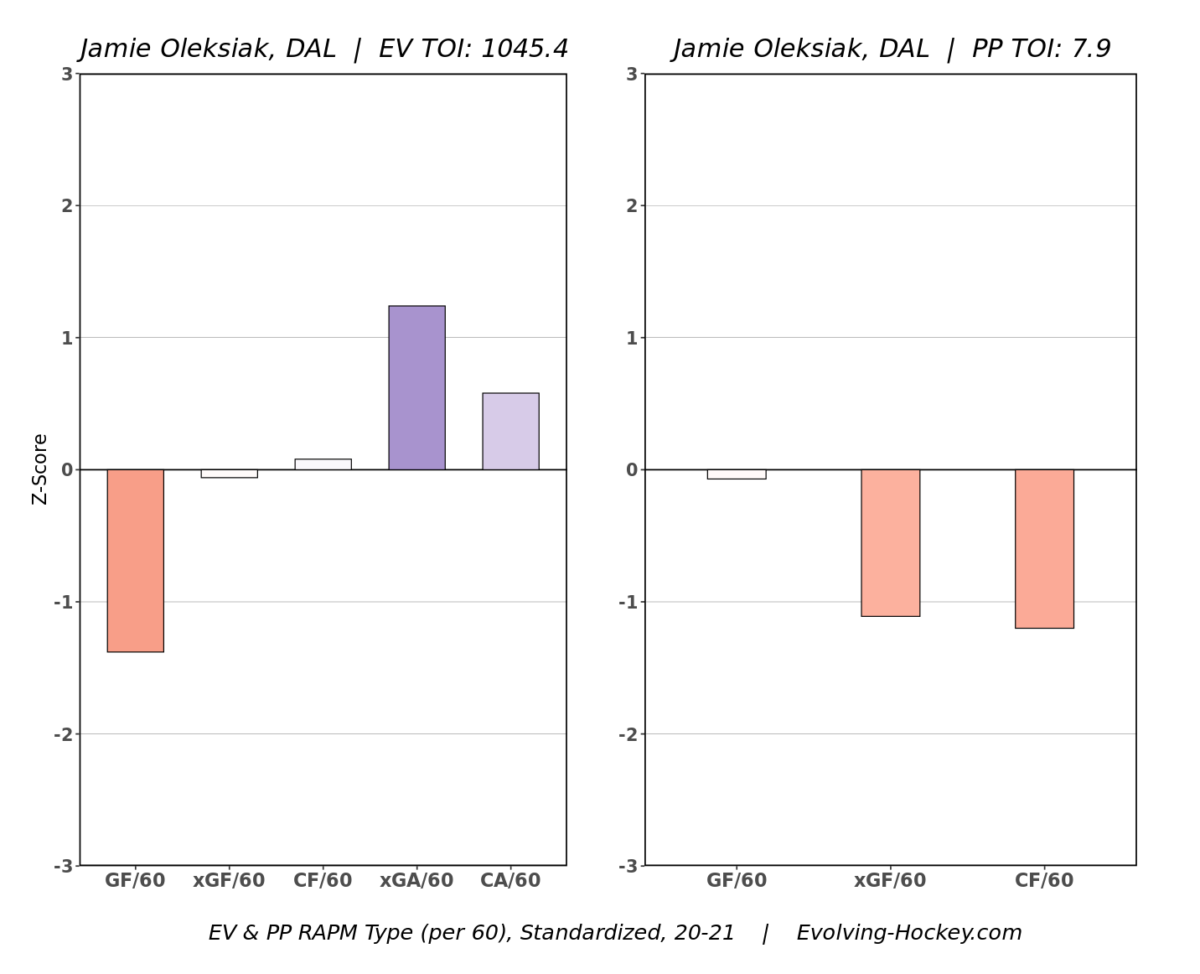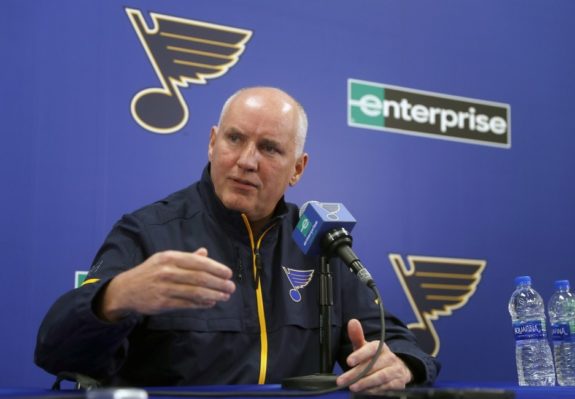For most teams, the hockey offseason is upon us, and it’s time to start evaluating what moves teams need to make to improve their squad for the season ahead. The St. Louis Blues ended their 2020-21 campaign in disappointing fashion with a four-game sweep in the first round at the hands of the Colorado Avalanche. Fans and the media alike asked plenty of questions, but one answer came to the top frequently: the Blues’ defense fell short.
That pill becomes harder to swallow as former captain Alex Pietrangelo moves deeper into the postseason with the Vegas Golden Knights. The restructured defense struggled to fill the void left when its best player departed in free agency, and the once-vaunted Blues defense looked average at best. General Manager Doug Armstrong will be looking to address that need this offseason. And the rumor mill keeps stopping on one name: Jamie Oleksiak of the Dallas Stars.
Why Do the Blues Need Help?
The first things fan recognize about Oleksiak is his size. The defender towers over most NHL players at 6-foot-7, 255 pounds, larger even than the Blues’ own totemic defenseman, Colton Parayko. Most analysts, including Blues’ beat reporter Jeremy Rutherford, believe it’s a major offseason priority to add size on defense: “The Blues can’t sugarcoat it: They were pushed around in their own end this season… the Blues became pushovers on the blue line… [and] are going to have to make a trade or find a free-agent fit this summer” (from ‘The Blues’ 10 biggest offseason priorities as an important summer begins,’ The Athletic NHL, May 24, 2021). Oleksiak certainly could fill that void.

The Blues’ team identity starts on defense. They were a vaunted unit in 2018-19, when the team won the Cup, thanks to the production of players like Pietrangelo and Vince Dunn and the shutdown capacity of Parayko and Jay Bouwmeester. But turnover changed the Blues’ defense dramatically, and in the 2020-21 season, they were little more than average. In fact, they were dead middle of the pack in the NHL in expected goals against per 60 (xGA/60, 2.32) at 5-on-5. And due to the team’s paltry offense, that resulted in a 27th-place finish in expected goals for percentage (xGF%) at 45.21 percent. Clearly, if Armstrong intends for his team to play the kind of grinding, physical, shutdown hockey that brought the Stanley Cup to St. Louis, he needs to make changes to his blueline.
What Does Oleksiak Offer?
Apart from his size, Oleksiak has become a very reliable defender over the past several seasons, especially since forming a reliable partnership with Miro Heiskanen. He will not be an offensive contributor, as his career-high is 17 points in a season. But he performed admirably in several metrical categories during the 2020-21 season.
Oleksiak finished with a 54.32 percent xGF%, 10th on the Stars, and significantly better than the Blues’ 45.21 percent mark as a team. He allowed just 1.89 xGA/60 at 5-on-5, better than any Blues player who played more than 200 minutes this season (only Dakota Joshua, a depth forward with limited opportunities, did better). And, in a number that will make many Blues fans happy, he led the Stars in hits with 148. Justin Faulk led the Blues but topped out at 127. A quick look at Oleksiak’s RAPM chart shows that he is a strong defensive contributor.

Those numbers paint a very clear picture: Oleksiak won’t be a point contributor and won’t add value on the power play. But the Blues shouldn’t need either. In theory, Faulk, Torey Krug, and Dunn (if the Blues keep him), can all provide scoring punch from the blueline. Oleksiak also won’t boost the power play, but once again, the Blues’ unit that finished sixth in the league last season shouldn’t need it. The Stars’ defenseman would bring size, physicality, and shot and opportunity suppression, especially at even strength. Those are several of the needs the Blues want to fill. So is it a good fit?
Is Oleksiak a Good Fit for the Blues?
There’s no question that the Blues need to add size, physicality, and reliability to their defensive unit. And Oleksiak would fill many of those needs. But is it a good match? Let’s ask a few more questions to determine an answer.
What Will the Contract Look Like?
Oleksiak is finishing a three-year contract with an average annual value (AAV) of $2.137 million. It’s safe to conclude he’ll make considerably more than that on his next deal. He’s 28 now, meaning that this will be his best opportunity to cash in on a significant deal. Evolving-Hockey projects his contract as a five-year deal with a $4.18 million AAV. But given that most view him as a top free agent in a shallow defensive free-agent class, it may take even more to pry him out of Dallas. Let’s assume that an Oleksiak contract would cost the Blues a $4.5 million AAV for five seasons.
Where Would Oleksiak Play?
Ever since the sudden and frightening loss of Bouwmeester, Parayko has struggled to find a consistent defensive partner. Oleksiak, a left-handed defenseman, would be an obvious fit, and the Blues’ best chance of forming another shutdown defensive pairing. The two giants would likely become the Blues’ nominal first-pairing but after Parayko’s disappointing season, it might be a stretch to call either a true first-pairing defender.
Should the Blues Sign Oleksiak?
Signing Oleksiak would unquestionably address most, perhaps all of the Blues’ biggest concerns on defense. And he’s unlikely to command a price that the Blues find prohibitive unless his services force teams into a bidding war. But that seems less likely in a flat-cap era. Still, it might not be the move Armstrong wants to make.

In recent seasons, it seems Armstrong is building a smaller, faster team focused more on the transition game. Signing Krug and Mike Hoffman (albeit it to a one-year contract) and focusing on youngsters like Jordan Kyrou and Robert Thomas gives that distinct impression. Oleksiak would be a clear departure from that mindset.
More importantly, if the Blues signed Oleksiak for around $4.5 million, they would have $23 million committed to a top-four without a clear first pairing, and all four would be at least 28 years old. Given the length that they’d have on Faulk, Krug, and Oleksiak’s contract, that’s a recipe for a rebuild if it’s not a perfect fit. The signing would also render Marco Scandella, who is owed $3.275 million for three more seasons, something of a costly afterthought. Moreover, that $23 million number would only increase if Armstrong intends to keep Parayko, who is an unrestricted free agent after the 2021-22 season.
The Verdict: Oleksiak Stays in Dallas
Ultimately, signing Oleksiak might be one of those opportunities that seem ideal, but is too costly for the team to actually execute. Yes, he fits many team needs, but the Blues’ defensive core is already costly, aging, and lacking in top-line skill. Oleksiak would add many valuable attributes, but he wouldn’t break any of those worrying trends.
With that said, it seems very possible that this won’t become an issue. Oleksiak is the Stars’ most important free agent. It seems unlikely that he will actually ultimately leave. Stars’ GM Jim Nill decided not to trade him at the deadline, signaling his desire to keep Oleksiak on another deal. He forms too reliable a partnership with their young, star defenseman to risk breaking up that chemistry. Oleksiak is likely to remain in Dallas unless a team severely overpays to keep him, and if that happens, the Blues should not be that team.